If you’re juggling multiple tasks, projects, and teams, you need a dependable platform to keep all your data safe, accessible, and organized from a single location. That’s why businesses are turning to project management solutions to take the stress out of their work.
In this article, we’ll cover the features, benefits, and pricing of ClickUp vs. Asana to determine if either is right for your business. We’ll also introduce you to the monday.com Work OS as a powerful ClickUp alternative to streamline your workflows.
ClickUp vs. Asana: the gist up front
At first glance, ClickUp and Asana have a lot in common. Each project management system allows you to:
- Assign tasks
- Share documents
- Track KPI progress
- Communicate with team members
Additionally, both offer a free pricing plan and integrate with third-party tools to create a unified workspace for your teams. But as you might imagine from a comparison article, these platforms have numerous differences.
ClickUp is best for: large teams with complex project management needs, such as deep folder or system hierarchies.
Asana is best for: teams who want to hit the ground running with a project management system that’s easy to set up, intuitive to use, and aesthetically pleasing.
What is ClickUp?
ClickUp was launched in 2017, so a relative newcomer to the project management space. It has established itself as a highly customizable project management platform that is “one app to replace them all.” It works as a project management tool, to-do list, OKR tracker, and email and chat app to reduce context switching between multiple other tools you’d use to handle these separate work tasks.
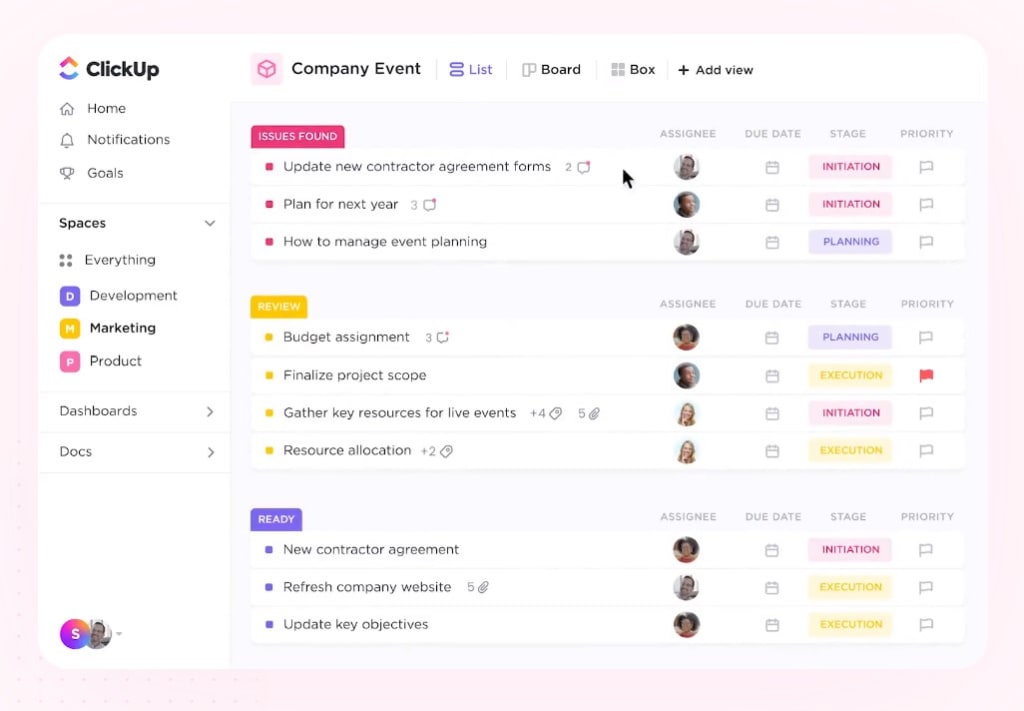
ClickUp’s key features
ClickUp is a feature-rich platform that includes:
- Customizations: Build your platform from scratch to look precisely how you want and include everything you need.
- Integrations: ClickUp supports 50+ native integrations but also links to Zapier for thousands more third-party integration options.
- Dashboard views: Choose from a variety of in-built views like Gantt or Timeline, along with mind maps, workloads, tables, and more.
- Embedded views: Import views from third-party apps like Miro or Airtable and work with the data directly from ClickUp.
- Collaboration: Create individual Spaces for your teams to communicate and share project updates.
Check out our detailed Clickup vs monday.com comparison.
ClickUp’s drawbacks
ClickUp is a blank canvas to build a custom-built project management platform for your business. In theory, this is a benefit, but the reality is that it can be overkill for smaller teams or those without the technical know-how to put it all together. And with such a breadth of features, there’s also a steep learning curve during onboarding. This is noted by G2 software reviews, which give ClickUp a score of 8.3 out of 10 for ease of setup, compared to 8.7 for Asana and 8.8 for the monday.com Work OS.
What is Asana?
Asana was founded by former Facebook executives in 2008 as an internal tool called “Tasks,” which internal team members used to “help everyone track their work.” It launched commercially in 2012.
Asana is a traditional project management tool focused on streamlined simplicity. Its aesthetically pleasing and intuitive home screen makes it easy to navigate, especially for first-time users. Don’t be fooled though — this tool isn’t just for beginners and small teams; the software’s capabilities are also suitable when managing large companies’ projects. For example, Uber and AirBnB reportedly use Asana in their tech stacks.
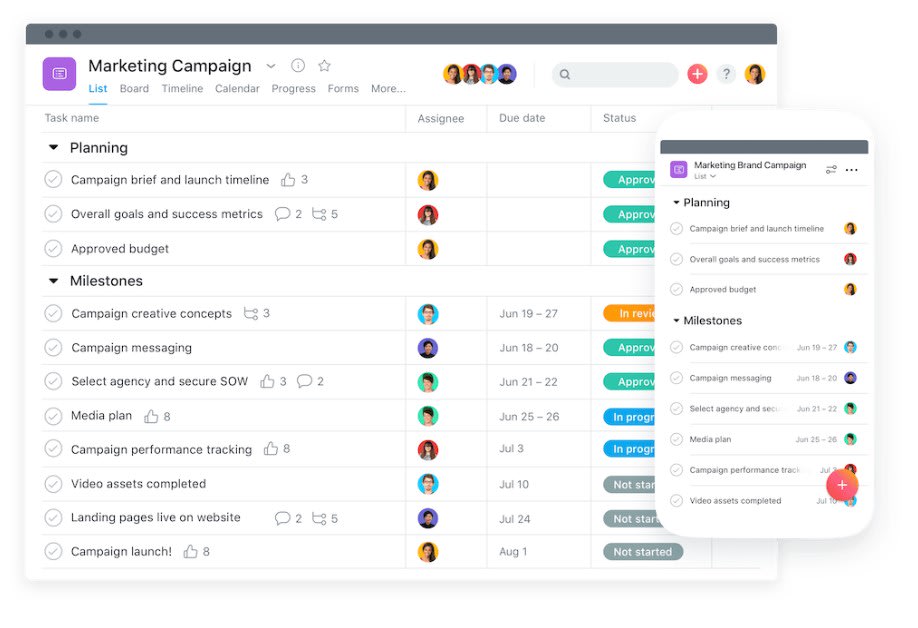
Asana’s key features
Asana offers the following features as part of its project management tool:
- Views: Choose from List, Timeline, Calendar, Kanban board, and Gantt Charts to keep your projects on track and spot problems at a glance
- Workload: Prevent burnout with this capacity planning feature, enabling you to track which team members are handling which project tasks
- Reporting: Gain real-time insights into your projects and troubleshoot issues as they crop up
- Automation: Set up custom workflows with rules to trigger routine tasks and reduce time-wasting activities
- Integrations: Asana has 200+ native integrations and also links with Zapier for access to thousands more
- Celebrations: Enjoy an occasional visit from the Asana celebration creatures when you check a task completion box
Read more about Asana’s features in our blog post on Asana work management!
Asana’s drawbacks
Asana is a solid out-of-the-box solution, but customizations are only available on premium plans. In comparison, ClickUp’s wide range of customization options are available across all plans, including the free version.
When should you choose ClickUp vs. Asana?
Deciding between ClickUp and Asana can be a conundrum and will ultimately boil down to your specific business and project management needs.
Choose ClickUp if:
- You’re equipped with in-house knowledge and experience to craft a customized project management solution for your business.
- You have a small budget.
- You’re not in a rush and have time to craft the perfect project management platform.
Choose Asana if:
- You prefer a traditional project management tool.
- You don’t want to build a customized solution for your business from scratch.
- You don’t need the bells and whistles of a more advanced tool.
Power project management with the monday.com Work OS
If you’re looking for a robust alternative to ClickUp and Asana, monday.com is a Work Operating System (Work OS) you can use to organize any project or workflow. For example, a marketing team could use it to plan a launch campaign, a software team could use it to track the development of a new app, and a finance team could use it to track budget allocations. Check out how it compares to ClickUp and Asana by looking at the G2 scores below.
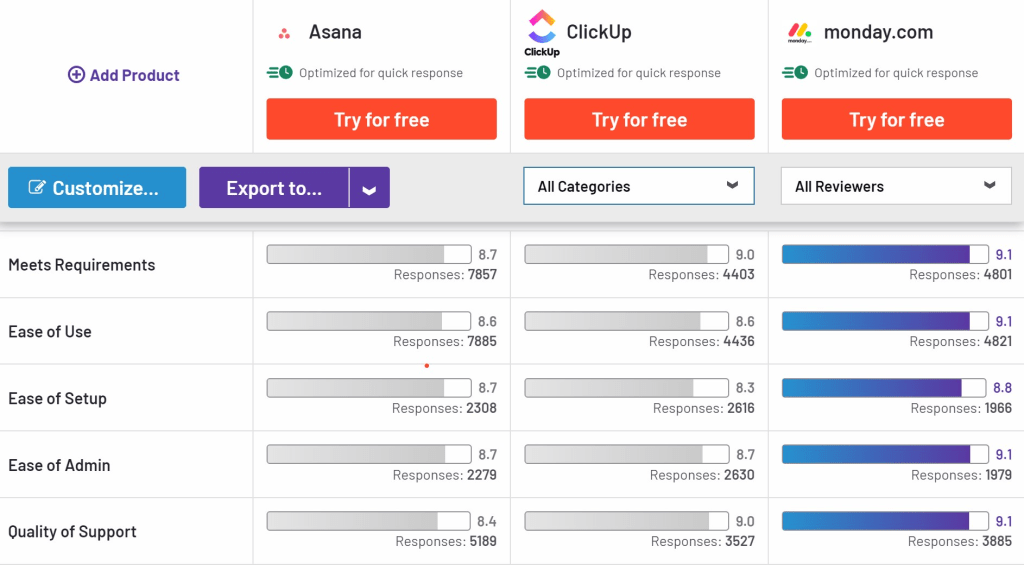
Unlike some basic project management tools, the monday.com Work OS enables teams to manage tasks and projects through every phase — from structuring workflows to resource management, and time tracking to collaborating with distributed stakeholders and managing customer data. Here are the features you’ll use to track your team’s work.
- Visual dashboard: Choose from Kanban boards, Timelines, Calendars, Gantt Charts, Maps, Forms, Workload, and more to gain immediate insight into your projects and capacity management. Transform your data so you can visualize it how you want to — whether colorful, elaborate or classic.

- Automations: Use the custom automation recipe builder to create complex workflows. You can automate reminders and mundane tasks and even send out notifications and emails on your behalf. Why waste more time on what your PM tool can do for you?
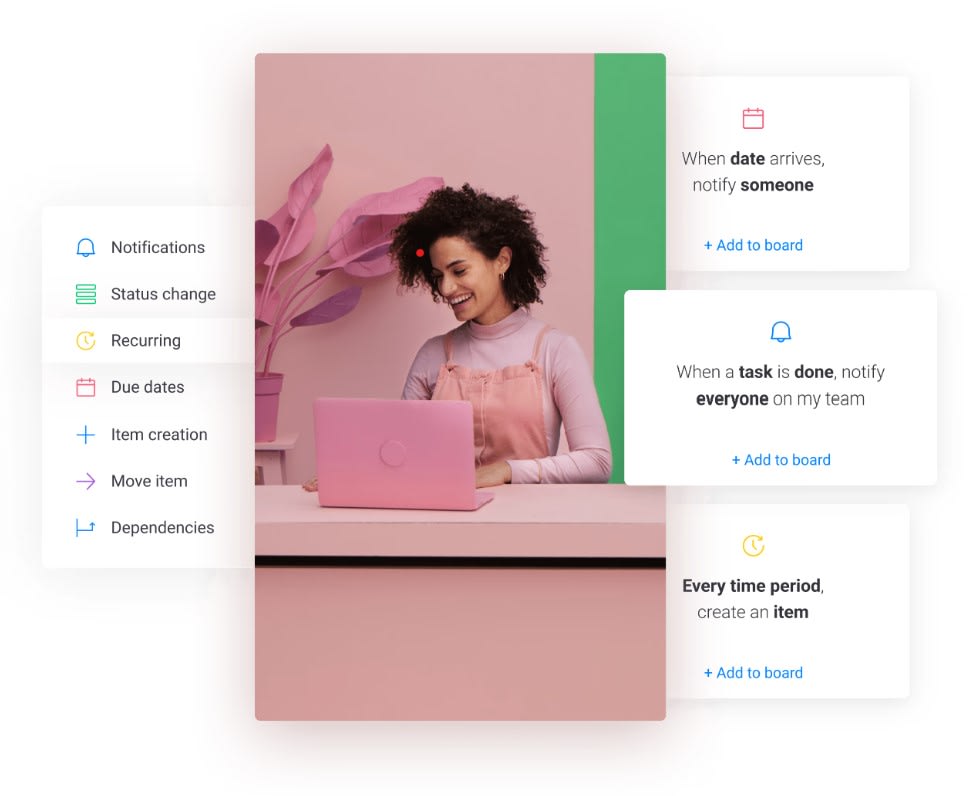
- Integrations: Seamlessly integrate the monday.com Work OS with 72+ of your favorite tools to finally have all your work and data in one place! Set up endless integrations in just a few clicks and choose from a variety of CRM, marketing, and software development integrations.

- Pre-built templates: We offer hundreds of templates to get your team started in minutes. Customize the template according to your needs, and save it for next time.
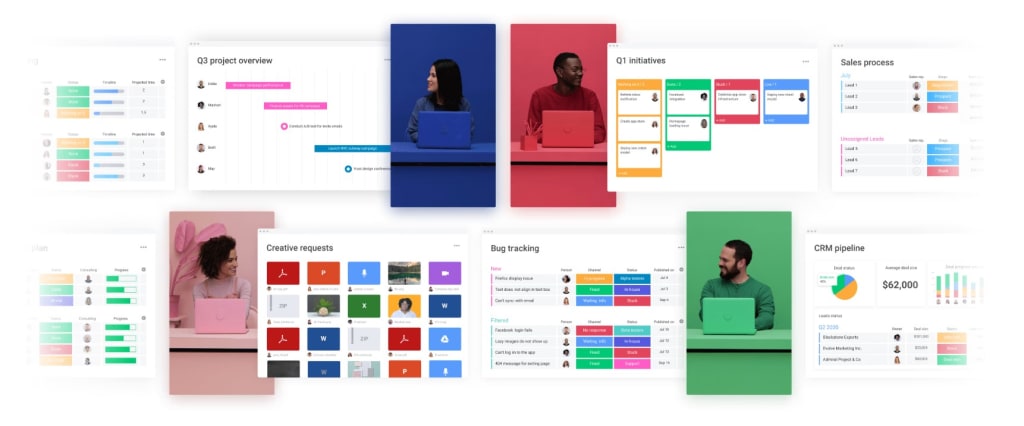
The monday.com Work OS offers these features and many more to supercharge your project management. Explore them for yourself by signing up for a free trial.
ClickUp vs. Asana vs. monday pricing
Each project management platform has a range of price plans to suit your needs, team size, and budget.
ClickUp’s pricing
ClickUp offers five pricing tiers as follows:
- Free: best for personal use. Includes 100MB storage, plus unlimited tasks, and unlimited free plan members.
- Unlimited: from $5 per member per month. This plan is best for small teams and includes unlimited storage, unlimited integrations, unlimited dashboards, and guests with permissions.
- Business: from $12 per member per month. This plan is best for mid-sized teams and includes enhanced security features, advanced automation, and custom exporting.
- Business Plus: from $19 per member per month. This plan is best for multiple teams and includes team sharing, custom role creation, and custom permissions.
- Enterprise: prices are available on request. This plan is best for multiple large teams and includes white labeling, enterprise API, and team sharing for Spaces.
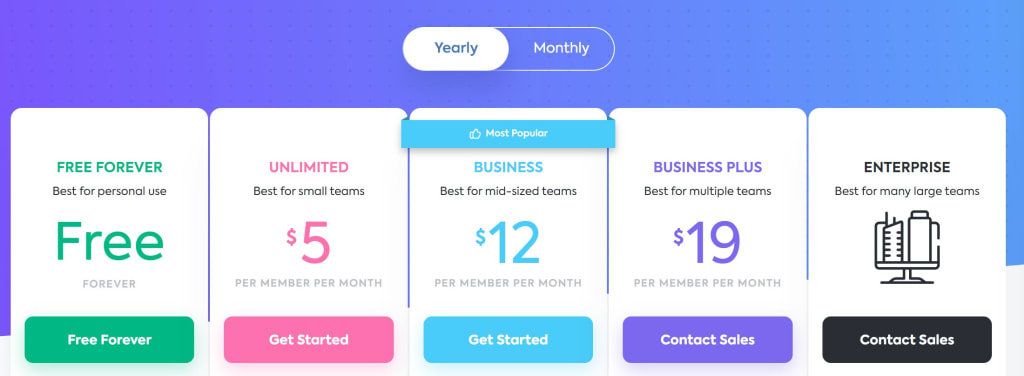
Asana’s pricing
Asana offers four pricing tiers as follows:
- Basic: free forever. This plan is best for teams of up to 15 users. It offers unlimited tasks, projects, and conversations, plus List, Board, and Calendar view projects.
- Premium: from $10.99 per member per month. This plan is best for teams that need to create small project plans. It includes advanced search & reporting, custom fields, task dependencies, and custom templates.
- Business: from $24.99 per member per month. This plan is best for teams and companies that need to manage work across initiatives. It includes portfolios, lock custom fields, and resource management.
- Enterprise: custom quotes for large-scale organizations are available on request. This plan has added security, control, and support.

monday.com’s pricing
monday.com offers four tiers plus a free 14-day trial to test-drive the innovative features of the monday.com Work OS. Each tier is based on a price-per-seat model, and discounts are available if you opt to pay annually.
- Basic: from $9 per seat per month. This plan is best for solopreneurs or small teams who must organize their tasks from one location. You’ll receive unlimited items, docs, boards, 200+ templates, 36+ column types, and a Kanban view.
- Standard: from $12 per seat per month. This plan is best for mid-sized teams who need to create dashboards of up to 5 boards. It includes Timeline, Gantt, and Calendar Views, automations, integrations, and guest access.
- Pro: from $19 per seat per month. This plan is best for teams with more complex workflows you need to create dashboards of up to 10 boards. It includes private boards and docs, formula columns, time tracking, Chart View, integrations, and automations. .
- Enterprise: custom quotes are available on request. This plan is best for large companies that need to build dashboards of up to 50 boards. It also offers advanced security and analytics.
ClickUp vs. Asana vs. monday customer support
Project managers need peace of mind that their tool will be fully functional and available to support their work round the clock. So, what type of customer support does each vendor offer if you need to troubleshoot an issue?
- ClickUp: offers 24/7 support on all plans, including the free version. The vendor also publishes online resources as a knowledge base for users
- Asana: only offers 24/7 support for customers who have paid for the top-tier Enterprise plans. They also have a library of support articles available for self-troubleshooting.
- monday.com: G2 reviewers score monday.com higher than ClickUp and Asana for quality of support, with an impressive 9.1 rating out of 10. As you can see, we make customer support a top priority; all users can expect 24/7 support on any day of the year. Along with phone support, monday.com offers a community forum, web contact form, knowledge base, and instructional videos.
FAQs
Is ClickUp or Asana better?
Deciding between ClickUp and Asana will depend on your specific needs. ClickUp is a customizable platform suitable for businesses with the resources to tailor it to their requirements. In contrast, Asana is a more traditional project management tool that requires less technical know-how and customization.
What makes ClickUp different?
ClickUp has a wide range of customization options, even on the free plan, giving users more flexibility in how they structure their workflows.
Is ClickUp or Asana more expensive?
Both platforms offer a free version, but Asana is more expensive than ClickUp when comparing the premium plans.
Which is the best project management platform for your business?
The monday.com Work OS is a strong alternative to ClickUp and Asana which scores higher than both on the G2 software review platform. Asana scores 4.3 out of 5, compared to ClickUp and monday.com, which both score 4.7. However, customer reviews give the edge to monday, which scores 9.1 out of 10 for ease of use, compared to ClickUp’s 8.6.
Why not test the monday.com Work OS out for size? Take a free 14-day trial today, with no credit card required.
Related articles: Asana vs. monday.com, Asana vs. Jira, Asana vs. Wrike, Airtable vs. Asana, Trello vs. Asana, Smartsheet vs. Asana, monday.com alternatives


